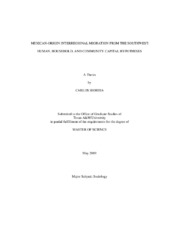| dc.description.abstract | This research addresses the question of what factors lead Mexican-origin individuals living in the U.S. to seek a new residence outside their Southwestern state of residence. The analysis examines three hypotheses: (1) the human capital hypothesis that college graduates have higher odds of migrating out of the core region than those with less than a high school education; (2) the household social capital hypothesis that posits that the presence of a household member born outside the core increases the odds of migration; and (3) the community social capital hypothesis which states that householders residing in an area with community social capital will have higher odds of leaving the core than those living in areas with no community social capital. These hypotheses are investigated using three models: (1) a full model that includes both native- and foreign-born Mexican-origin householders; (2) a native-born model which includes only native-born Southwest householders; and (3) a foreign-born models that includes only foreign-born Mexican-origin householders. By using the Saenzian region-concepts of core, periphery, and frontier, I find: (1) limited support for the human capital hypothesis; (2) consistent support for the household social capital; and (3) no support for the community social capital. The analysis is important to sociological theory and demography because it specifically endeavors to explain how the connections between three kinds of capital?human, household, and community?shape the decision to leave the Southwest for other regions of the country. By computing statistical and theoretical particulars, the thesis ascertains that migration-selectivity theories regarding the general population are useful in theorizing Mexican-origin interregional migration. Findings expand existing sociological literature by theorizing how human, household, and community capital operate under the Saenzian regions to shape the interregional migration of the growing Mexican-origin population of the U.S. | en |


